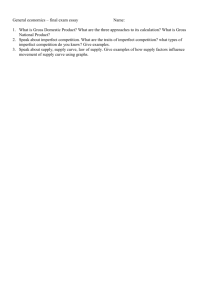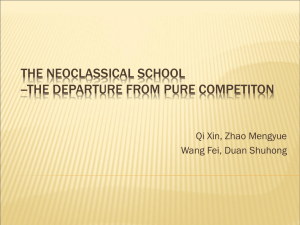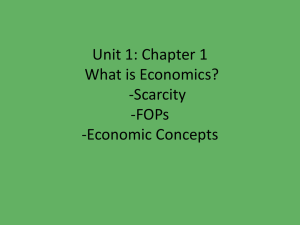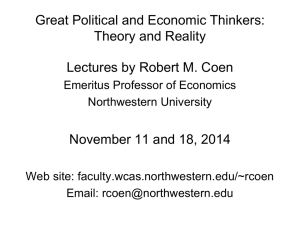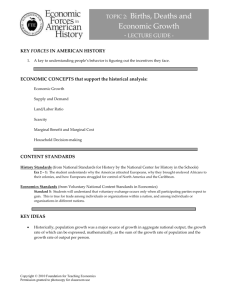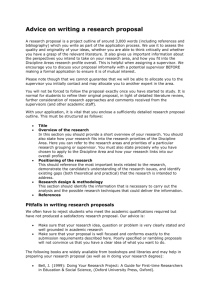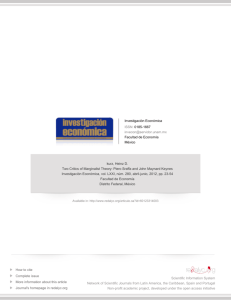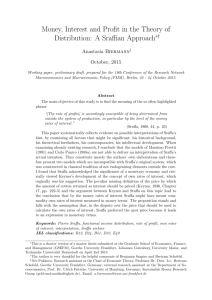From market "imperfection" to "market" failure
advertisement
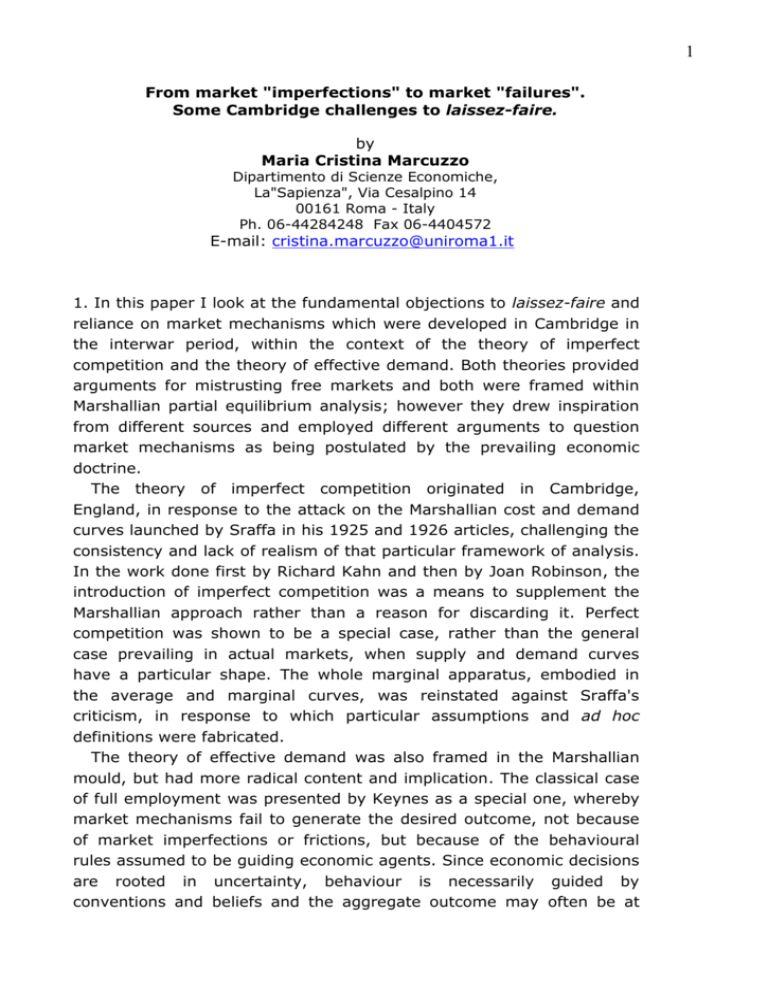
1 From market "imperfections" to market "failures". Some Cambridge challenges to laissez-faire. by Maria Cristina Marcuzzo Dipartimento di Scienze Economiche, La"Sapienza", Via Cesalpino 14 00161 Roma - Italy Ph. 06-44284248 Fax 06-4404572 E-mail: cristina.marcuzzo@uniroma1.it 1. In this paper I look at the fundamental objections to laissez-faire and reliance on market mechanisms which were developed in Cambridge in the interwar period, within the context of the theory of imperfect competition and the theory of effective demand. Both theories provided arguments for mistrusting free markets and both were framed within Marshallian partial equilibrium analysis; however they drew inspiration from different sources and employed different arguments to question market mechanisms as being postulated by the prevailing economic doctrine. The theory of imperfect competition originated in Cambridge, England, in response to the attack on the Marshallian cost and demand curves launched by Sraffa in his 1925 and 1926 articles, challenging the consistency and lack of realism of that particular framework of analysis. In the work done first by Richard Kahn and then by Joan Robinson, the introduction of imperfect competition was a means to supplement the Marshallian approach rather than a reason for discarding it. Perfect competition was shown to be a special case, rather than the general case prevailing in actual markets, when supply and demand curves have a particular shape. The whole marginal apparatus, embodied in the average and marginal curves, was reinstated against Sraffa's criticism, in response to which particular assumptions and ad hoc definitions were fabricated. The theory of effective demand was also framed in the Marshallian mould, but had more radical content and implication. The classical case of full employment was presented by Keynes as a special one, whereby market mechanisms fail to generate the desired outcome, not because of market imperfections or frictions, but because of the behavioural rules assumed to be guiding economic agents. Since economic decisions are rooted in uncertainty, behaviour is necessarily guided by conventions and beliefs and the aggregate outcome may often be at 2 variance with what is individually pursued. Thus, market mechanisms cannot be relied upon as the best means to obtain a high and stable level of output and employment. Once market "failures" rather than market "imperfections" are taken on board, the traditional view of the economy as governed by "natural" forces and, with it, the implied universal validity of economic laws are seriously undermined. In the following pages I re-examine these two challenges to freemarket economics developed in Cambridge in the interwar period, to conclude with some remarks on how these views have been contrasted by the Chicago School since the 1940s with the aim of re-establishing the dominance of perfect competition and reliance on market forces. 2. Sraffa's suggestion to "abandon the path of perfect competition and turn to the opposite direction, namely, towards monopoly" (Sraffa 1926: 542) paved the way for development of the theory of imperfect competition in Cambridge in the 1930s.1 The reasons Sraffa gave for abandoning that hypothesis within the Marshallian-Pigouvian apparatus were twofold. Firstly he held that the theory in which the hypothesis was embedded was logically inconsistent, and secondly that the behavioural descriptions implied by perfect competition were at variance with known facts. According to Sraffa, the assumption that long period costs for the firm are increasing when conditions of perfect competition hold is the result of mistakenly attributing to a single firm what was attributable, under particular circumstances, only to an industry. Since each firm is too small to have an appreciable influence on the price of its factors, the result of an increasing marginal cost for the firm can be obtained only by assuming that each firm, as it expands production, experiences a decrease in productivity. But this can be justified only for a firm that happens to be the sole employer of a factor that cannot be augmented. The assumption of decreasing average costs is also inconsistent with the theory of perfect competition. If it is admitted that there is a firm whose costs per unit of output decrease when production increases, what is there to prevent that firm from expanding production The contemporary appearance of Chamberlin's book (Chamberlin 1933) clearly indicates that dissatisfaction with the perfect competition assumption was not confined to Cambridge, England, and indeed that imperfect competition theory had, at least in the U.S, another source of inspiration. See Chamberlin (1961), Reinwald (1977); for a different view see Samuelson (1967). 1 3 indefinitely and becoming a monopolistic producer in that market? Finally, if it is assumed that firms operate with constant costs a further difficulty arises for the theory of perfect competition in the MarshallPigou tradition, which assumes that the firm faces a perfectly horizontal demand curve. In fact, given constant costs, either the equilibrium is undetermined or, if it is postulated that firms always produce as much as possible, the possibility of one single firm monopolising the market cannot be ruled out. Lack of realism in the theory of perfect competition –in the form given to it by the Marshallian-Pigouvian apparatus -is revealed by the common knowledge that producers are not usually constrained by increasing costs, but by the extent of their own market. In contrast to what is observed in most markets, that theory assumes that while firms can sell any quantity whatsoever at the given market price, they are unable to lower prices or to increase marketing expenses in order to increase their market share. As a way out of this quandary Sraffa suggested that firms should be regarded as single monopolies since, within the Marshall-Pigou apparatus, this hypothesis functioned better than perfect competition in accounting for the evidence, that is, that the expansion of firms is halted not by rising costs but by demand (Marcuzzo 1994a, pp. 64-6). Lack of realism was also the reason given by Kahn for discarding perfect competition in his analysis of the cotton and coal industries in his Dissertation2, on the Economics of the Short Period, which is the first "Cambridge" contribution to the theory of imperfect competition.3 According to Kahn, the Marshallian-Pigouvian apparatus could not account for a fact which was being observed during the Depression of 1920s: firms earned a positive profit while working below capacity; in situations in which demand was low, firms used "to close down the The Dissertation, which secured Kahn with a fellowship at King's in 1930, remained unpublished in English until 1989; although it was until then read by only very few people (see Kahn 1989: xii), many were aware of its importance. 3 Indeed, in Marshall and Pigou some loose elements of imperfect competition theory can be found (Whitaker 1989). Shove's lecture notes for the academic year 1928-1928 taken by J. Saltmarch (King's College Library) show that he had made important advances in the analysis of the "intermediate" case between competition and monopoly. Harrod, while based in Oxford, had in 1928 sent an article –which Keynes rejected- for the Economic Journal in which the marginal revenue curve was clearly presented. See Harrod (1976:304n) 2 4 whole plant on some days and to work the whole plant a full shift on other days." (Kahn, 1989, p. 57). The explanation was sought in the shape of the prime cost curve, reflecting the technical method with which output could be varied in the short period. Kahn concluded that, in the short period (namely when the plant and machinery could not be altered) the relevant segment of the marginal cost curve is horizontal: marginal cost is equal to constant average cost until full capacity is reached. The shape of the prime cost curve – a reverse L- and the evidence of short-time working are a serious challenge to the theory of perfect competition. Whenever the price exceeds the average cost curve, firms are supposed to be producing at full capacity level of output. But if this were so, the only inefficient firms would be those that worked below capacity, which went against the evidence. Thus, when faced by a perfectly elastic demand curve, a constant marginal cost curve loses its significance as determinant of output. Kahn found the solution in the assumption of an imperfect market, namely a downsloping demand curve facing each firm. In this case both the equilibrium output and price can be determined not, as in perfect competition, by the equality of price and marginal cost, but as in monopoly by the product and the difference between price and average prime cost, as far as output is concerned4 and on the basis of elasticity of demand as far as price is concerned. By introducing the imperfection of the market, Kahn was able to explain why at low level of demand price does not fall to marginal cost and why the equilibrium level of output is at less than full capacity. The approach taken by Joan Robinson in the Economics of Imperfect Competition was to apply the technique based on average and marginal curves, incorporating various cost and demand conditions of commodities and factors of production, to all market forms. Perfect competition becomes a special case in a general theory of competition, allowing for various degrees of substitution and preferences on the part of consumers as captured by the value of the elasticity of demand. Perfect competition is then defined as a market condition characterised by a perfectly horizontal demand curve, i.e. with infinite elasticity. On the supply side, various assumptions are allowed for in the behaviour of costs, corresponding to increasing, decreasing and constant cost cases. In fact, in an imperfect market, namely with a downsloping demand Kahn applies here the standard definition of "maximum monopoly net revenue" provided by Marshall; at the time the dissertation was written, the term marginal revenue was still unborn. 4 5 curve facing each firm, any assumption about the shape of the marginal cost curve provides for the determinacy of equilibrium. In the hands of Joan Robinson, following in Kahn's steps, imperfect competition became the means by which the Marshallian-Pigouvian apparatus could again be given generality and validity against Sraffa's attack. No wonder Sraffa soon distanced himself from this line of research and pursued his research agenda against marginalist analysis in almost total isolation in Cambridge.5 (Marcuzzo 2001a). In the mid 1930s Kalecki, too, developed an approach based on imperfect perfect competition within a macroeconomic analysis of the economic system. When he arrived in England in 1936 he had already worked with the assumption that in many firms per unit prime costs were in fact fairly constant over a considerable range of output changes (Chilosi 1989, p. 106). The following year he moved to Cambridge and became an active participant in Sraffa's Research Students seminar. At the end of 1938, when the Cambridge Research Scheme of the National Institute of Economic and Social Research into Prime costs, Proceeds and Output was set up, Kalecki was actively pursuing a line of research in which firms were assumed to set prices on the basis of the degree of monopoly prevailing in each industry. In two articles written during his Cambridge period (see Kalecki 1938, 1940), market imperfection is defined as a function that relates the elasticity of demand for the product of each industry to the ratio between the price charged by the individual firm and the average price of the industry. The degree of market imperfection is constant if, for each individual firm, the elasticity of demand is correlated solely with its price; otherwise the degree of market imperfection varies with the average elasticity of market demand. In the 1940 paper Kalecki drops the assumption that firms fix prices according to the equality of marginal cost and marginal revenue –as in the Robinson-Kahn general framework of competition- and examines the case of firms setting the price at a point where marginal revenue is greater than marginal cost. The price is set at this particular level because each firm knows that a lower price would induce the rival firms However, when Sraffa's alternative approach became known, first in his Introduction to Ricardo's Principles and then in his Production of Commodities, Joan Robinson readily embraced Sraffa's position and dismissed her Imperfect Competition as a "blind alley."(CME: x). 5 6 to lower their prices, while a higher price would not make them raise it.6 In any given market, the degree of oligopoly is measured by the ratio of marginal revenue to marginal cost, which is in general greater than one. Kalecki was highly original, although at the cost of simplification, in producing a methodology to study the aggregate effects of price policy by firms in a macroeconomic representation of the economic system. (Marcuzzo 1996, pp. 11-12). Quite rightly Joan Robinson commented in the preface to the second edition of the Economics of Imperfect Competition "it was Kalecki", rather than she herself who "brought imperfect competition in touch with the theory of employment." (Robinson 1969: viii). By contrast Keynes remained unimpressed by imperfect competition and worked his way through the General Theory without taking much notice of it. This has given rise speculation and various interpretations have been given of why this is might have been so7. Clearly, it was not by introducing frictions and imperfections in the working of markets that he believed the assault on the "citadel" 8 could be effective; in fact he launched on a more radical attack on the way economic theory was being developed, as I shall argue in the next section. 3. In The General Theory Keynes rejects the "classical" conclusion that market forces are at work to bring the economic system to the full employment of resources. He explains, rather, that the level of employment oscillates around "an intermediate position", below full employment and above the minimum subsistence employment (CW VII: 254). And Keynes adds: "But we must not conclude that the mean position [of employment] thus determined by 'natural' tendencies, namely, by those tendencies which are likely to persist, failing measures expressly designated to Kahn's claim of priority for the concept of the "kinked demand curve" in the Dissertation (Kahn 1989: xix) is probably correct, although it was Kalecki who first used it within a macroeconomic setting. 7 For instance, Marris (1991) and Harcourt (1994) give very different explanations; the former stressed the "psychological aspects" of the relationship involving Kahn, Keynes and Robinson, the latter -with whom I agree -pointed to the "unnecessary complication" of introducing imperfect competition for Keynes' purposes in the General Theory. 8 In 1934, in the famous broadcast Is the economic system self-adjusting?, Keynes referred to the "whole body of organised economic thinking and doctrine of the last hundred theory" he was attacking as "the citadel." (CW XIII: 488) 6 7 correct them, is, therefore, established by laws of necessity. The unimpeded rule of the above conditions is a fact of observation concerning the world as it is or has been, and not a necessary principle which cannot be changed. (CW VII: 254, my italics) And he explains that in economics "we cannot hope to make completely accurate generalisations" (ibid.) because the economic system is not ruled by "natural forces" that economists can discover and order in a neat pattern of causes and effects. The task of economics is rather to "select those variables which can be deliberately controlled and managed by central authority in the kind of system in which we actually live". (ibid.) Keynes strenuously opposed the economists' attempts to imitate the standard of scientific inquiry set by physics, asserting as the object of economic theory that of developing a logical way of thinking about factors which are "transitory and fluctuating." (CW XIV: 297) He argued the view of economics as a "moral" rather than "natural" science, because "it deals with introspection and with values [...] it deals with motives, expectations, psychological uncertainties" (CW XIV: 300). While natural sciences aim at discovering regularities from which to derive general laws, economics is expected to capture the effects of decisions taken in an "uncertain" environment. An illustration can be found in the role assigned in the General Theory to expectations in explaining the possibility of an equilibrium at less than full employment. This type of equilibrium is not described as a situation characterised by "wrong" expectations but as a situation in which expectations generate "a state of things" which conforms to it. Thus economic theory is required to explain decisions taken under different conditions of knowledge by agents and not to discover absolute, general laws which the economic system obeys. This "relativist" stance, in Keynes's epistemology, can again be illustrated by reference to the General Theory. In fact, while the liquidity preference, the propensity to consume, the marginal efficiency of investment, the wage unit and the quantity of money are presented as the "ultimate independent variables", it is denied that this distinction could ever be general; on the contrary, the division is said to be "quite arbitrary from any absolute standpoint." (CW VII: 247). While Keynes was forging and presenting this view, Lionel Robbins published his Manifesto (Robbins 1932), where he claimed that arguments pertaining to ethics and political philosophy should be banned from economics. The message was that, while moral sciences 8 deal with what ought to be, economics is concerned with what is. Keynes fought for the opposite view. Indeed, he was challenging economics to abandon the "modernist claim" to be a scientific study of society and become an investigation "into problems which seek to bring about defined or desired end states (or solutions) and clarify values". (Parsons 1997: xiv) Once the fallacy of the analogy of economic laws with physical laws is exposed, the possibility to promote values and attitudes to change society as a whole becomes apparent. As Keynes put it: "It is many generations since men as individuals began to substitute moral and rational motive as their spring of action in place of blind instinct. They must now do the same thing collectively". (CW XVII: 453) Since letting individuals pursue self interest does not - contrary to the Smithian parabola of "the butcher, the brewer and the baker" - produce a social good, the goal is to change the environment within which they operate. This is Keynes's main argument against laissez-faire: first, there are no forces to harmonise individual interests and second, aggregate economic behaviour does not have the same outcome as individual economic behaviour, so what is good for the individual may not be good for the whole. The means to achieve changes in attitudes is to change the way in which people think about the "economic problem". This could be achieved, according to Keynes, through the power of persuasion. In a letter to T.S. Eliot of 5 April 1945, he wrote: "[...] the main task is producing first the intellectual conviction and then intellectually to devise the means. Insufficiency of cleverness, not of goodness, is the main trouble [...] Next the full employment policy by means of investment is only one particular application of an intellectual theorem. You can produce the result just as well by consuming more or working less. Personally I regard the investment policy as first aid. In U.S. it almost certainly will not do the trick. Less work is the ultimate solution (a 35 hour week in U.S. would do the trick now). How you mix up the three ingredients of a cure is a matter of taste and experience, i.e. of morals and knowledge." (CW XXVII: 384) Thus, Keynes saw the main task of economic theory as that of "transmuting human nature" rather than that of "managing" it (CW VII: 374). On the contrary, however, managing the economy - the so called Keynesian policies of "stop and go" or of "fine tuning" - rested on a representation of the economic system as a mechanism which can be relied upon to produce the desired results. According to these recipes, a 9 cheap money policy cannot fail to encourage investment, given the inverse relationship between investment and the rate of interest and the assumed stability of the liquidity preference schedule. There is always a trade-off between unemployment and inflation, assured by the negative slope of the Phillips curve and by expectations being generally adaptive (workers always expect the future rate of increase in money prices to be as in the past). Thus, Keynesian economics or, as it is also known, the neo-classical synthesis interpreted Keynes's message as a faith in managing the economy to achieve desired goals, such as a high level of employment and a low level of inflation, and relied on a model of the economy which could be empirically tested and whose predictions could be used to adjust instruments and tools of economic policy. The stress on forecasting, measurement and empirical testing was intended to enhance the scientific aspect of economics, where "scientific" meant again resemblance to the physical sciences - to their rigour and predictive power. The premise of a scientific approach was interpreted as the possibility of a clear demarcation between values and statements of facts, between science and ideology, between analysis and prescriptions. Robbins in his 1932 book had declared economics to be a science only is so far as it was value-free; Popper (1935) provided what seemed to be the solution to the demarcation problem, namely what scientific status required. In Keynes's own time this view was challenged, but never gained consensus among economists. In fact, Friedman's insistence on prediction as the only test for economic theories and Samuelson's mathematization of economics gave renewed strength to faith in imitation of the physical sciences as far as the chosen method of scientific inquiry is concerned. For his part, however, Keynes kept up the fight against attempts of deprive economics of its moral science status. For instance, on July 4, 1938 he wrote to Harrod: "against Robbins, economics is essentially a moral science and not a natural science. That is to say, it employs introspection and judgements of value. "(CW XIV: 297) In conclusion, the most significant implication of Keynes's rejection of the mechanical view of economics as a discipline aiming to discover "scientific" laws and be wertfrei, is the claim that "moral thinking" and "moral values" (CW XXVII: 387) are embedded in any social philosophy. The point at stake is how ends are better implemented and which institutions are more apt to the purpose of the social goal. Keynes 10 distrusted markets and believed, rather, in alternative means to improve society, resting on persuasion and intellectual ingenuity.9 In a speech to the House of Lords, on May 23, 1944, he wrote: "[for the last twenty years] I have spent my strength to persuade my countrymen and the world at large to change their traditional doctrines and, by taking better thought, to remove the curse of unemployment". (CW XXVI:16, my italics). Clearly, by "better thought", Keynes meant a theory which might, among other things, make the eradication of unemployment possible, rejecting the doctrine that whatever unemployment there may be is "natural" as long as it is market generated-. As he foresaw in the famous letter to G.B. Shaw, he had written the book on economic theory "which will largely revolutionise [...] the way the world thinks about economic problems" (CW XIII: 492). Interestingly, in the same letter he had added: "When my new theory has been duly assimilated and mixed with politics and feeling and passions [...] there will be a great change" (ibid: 493). Once again, far from appealing to the scientific superiority of his own theory, he entrusted "politics, feelings and passions" to get the message through. (Marcuzzo 2001b) 4. The main implication of working with the hypothesis of imperfect competition is that, when firms do not face horizontal demand curves, the argument that competitive markets result in economic efficiency cannot be made. (Stiglitz 1992). With imperfect competition, scope for intervention and institutional changes is made for and confidence in markets as best means to allocate resources is undoubtedly shaken. However, the history of imperfect competition theory as developed in the interwar period showed that it was not an alternative research programme since –with the possible exception of Kalecki –it did not undermine the validity of the neoclassical approach to economics. In the General Theory Keynes accepted many assumptions of the neoclassical theory –supply and demand analysis, profit maximisation, rising marginal costs, a given degree of competition- but he radically opposed the methodological implications that economic theory (even his own, for that matter) could claim universal validity and generality, regardless of the particular circumstances in which it might be applied. As Carabelli and De Vecchi (1998) aptly put it: "Keynes's institutions should compete with and try to contrast ethically undesired social practices and custom". 9 11 In terms of content, the General Theory conveyed the radical message that markets should not be left unguided and that intervention was indeed necessary and feasible. Unfortunately, this message was interpreted as the need to develop models exposing the mechanics rather than the logic of full employment policies. In the late 1940s and early 1950s, several Chicago based-scholars (in the main Milton Friedman and George Stigler) formulated criticisms of monopolistic competition theory against the claim that it was a more realistic model of the actual economy10. The argument was that the value of a theory does not lie in the realism of its assumptions, but in the realism of its predictions (Keppler 1994: 114, 116). The same argument was used by Friedman and other exponents of the Chicago School to contrast important concepts of the Keynesian theory and, later, to reaffirm the superiority of the approach based on the Quantity Theory of Money and the Natural rate of Unemployment by virtue of their superior predictive power11. The attack moved rapidly from the role of market imperfections to challenging the appropriate test for proving market failure. Unfortunately, the Keynesians were forced to accept the ground of comparing empirical results on the basis of the models constructed on varying elasticity of the IS-LM curve. From the early Seventies to the early Eighties the war was fought, ending with the defeat of the Keynesians and a short-lived victory of the Monetarists. Since the early Eighties the New Classicals and the New Keynesians have been confronting each other again over the very issues of "imperfections" and "rigidities" versus "market-clearing", and of behaviour based on "rational expectations" versus "uncertainties and information asymmetries". In recent years we have thus witnessed a return of imperfect competition in modern micro and macro models as a way of contrasting and enriching the basic perfect competition models12; in the meantime An example is provided not only by the famous 1949 article by Stigler in which he denounced imperfect competition as lacking generality and being empirically empty, but also in his attack on Paul Sweezy's work on the kinked demand curve. See Sutton (1989) and Freedman (1995); in general on Stigler's attack on imperfect competition, see Keppler (1998). 11 For an overview of Friedman's position against Keynesian economics see Levrero (1999). 12 For a review of the main issues in both areas see Gabszewicz-Thisse (2000) and Dixon-Rankin (1994). 10 12 the Chicago methodological precepts do not seem to have stood up against criticism. Perhaps we may hope that some acceptance of Keynes' caution against the "naturalism" of economic laws may catch on, after all. 13 References Carabelli A. and De Vecchi N. (1998), "Hayek e Keynes su conoscenza, etica e economia" in M.C. Marcuzzo-N. De Vecchi (eds), A Cinquant'anni da Keynes. Teorie dell'occupazione, interesse e crescita, Milano, Unicopli, pp. 49-89. Chamberlin E. H. (1933), The Theory of Monopolistic Competition, Cambridge, Harvard University Press. Chamberlin E. H. (1961), The origin and early development of monopolistic competition theory, Quarterly Journal of Economics, 74 n. 4, pp. 515-43. Chilosi A. (1989), Kalecki's Quest for Microeconomic Foundations of his Macroeconomic Theory in M.Sebastiani (ed), Kalecki's Relevance Today, London, Macmillan. Dixon H. D. and N. Rankin. (1994), Imperfect Competition and Macroeconomics, Oxford Economic Papers, 46, April, pp. 171-99. Freedman C. (1995) The Economist as Mythmaker--Stigler's Kinky Transformation, Journal of Economic Issues 29(1), pp. 175-209. Gabszewicz J. J. and J. F. Thisse. (2000), Microeconomics Theories of Imperfect Competition, Cahiers d'Economie Politique, 37, Autumn, pp. 47-99. Harcourt G. C. (1994), Kahn and Keynes and the Making of The General Theory, Cambridge Journal of Economics, 18, Feb., pp. 11-24. Harrod R. F. (1976), Economic Essays, London, Macmillan. Kahn R. F. (1989), The Economics of the Short Period, London, Macmillan. Kalecki M. (1938), The Determinants of Distribution of the National Income, Econometrica, 6, n. 2, pp. 97-112. Kalecki M. (1940), The Supply Curve of an Industry under Imperfect Competition, Review of Economic Studies, 7, n. 2, pp. 91-122. Keppler J. (1994), Monopolistic Competition Theory. Origins, Results and Implications, Baltimora, The Johns Hopkins University Press. Keppler J. H. (1998), The genesis of 'positive economics' and the rejection of monopolistic competition theory: a methodological debate, Cambridge Journal of Economics, 22, n. pp. 261-276. Keynes, J. M. (1971-1989), The Collected Writings, ed. by D. Moggridge, XXX voll., London, Macmillan. (CW): vol. VII, The General Theory of Employment, Interest and Money 14 vol. XII, Economic articles and Correspondence. Investment and Editorial vol. XIII, The General Theory and After: Preparation vol. XIV, The General Theory and After: Defence and Development vol. XVII, Activities 1920-1922: Treaty Revision and Reconstruction vol. XXVI, Activities 1941-1946: Shaping the Post-War World: Bretton Woods and Reparations vol. XXVII, Activities 1941-1946: Shaping the Post-War World: Employment and Commodities Levrero E. S. (1999), Milton Friedman, Studi Economici, 68, n. 2, pp. 5-79. Marcuzzo, M.C. (1994a), At the origin of the theory of imperfect competition: different views ?" in K.I. Vaughn (ed), Perspectives on the History of Economic Thought, vol. X, Aldershot, Elgar, pp. 63-78. Marcuzzo, M.C. (1994b), "R.F.Kahn and Imperfect Competition", Cambridge Journal of Economics , Vol. 18, n. 1, pp. 25-40. Marcuzzo, M. C. (1996), Alternative Microeconomic Foundations for Macroeconomics: The controversy Over the L-shaped Cost Curve Revisited", Review of Political Economy , 8, n.1, pp. 7-22. Marcuzzo, M. C. (2001a), Sraffa and Cambridge economics, 19281931 in T. Cozzi and R. Marchionatti (eds), P. Sraffa’s Political Economy. A centenary estimate, London, Routledge, pp. 81-99. Marcuzzo, M.C. (2001b), "L'economia come scienza morale. Una nota sulla concezione di Keynes," in G. Mazzocchi and A. Villani (a cura di) Etica, economia, principi di giustizia, Milano, Franco Angeli, pp. 277-83. Marris R. (1991), Reconstructing Keynesian Economics with Imperfect Competition, Aldershot, Elgar. Parsons W. (1997), Keynes and the Quest for a Moral Science. A Study of Economics and Alchemy, Aldershot, Elgar. Popper K. (1935), Logik der Forschung, engl. ed. The Logic of Scientific Discovery, London, Hutchinson, 1959. Rheinwald T. P. (1977), The Genesis of Chamberlinian Monopolistic Competition, History of Political Economy, 9, n. 4, pp. 522-34. Robbins, L. (1932), An Essay on the Nature and Significance of Economic Science, London, Macmillan. Robinson J. [1933] (1969), The Economics of Imperfect Competition, London, Macmillan. 15 Samuelson P. A. (1967), The Monopolistic Competition Revolution, R. E. Kuenne (Ed.), Monopolistic competition Theory: Studies in Impact, New York, Wiley. Sraffa P. (1926), The Laws of Returns under Competitive Conditions, Economic Journal, 36, Dec., pp. 535-50. Sutton J. (1989), Is Imperfect Competition Empirically Empty? in G. R. Feiwel (ed.), The Economics of Imperfect Competition and Employment, London, Macmillan. Stigler J. (1949), Monopolistic Competition in Retrospect, in Five Lectures on Economic Problems, London, Longmans, pp. 12-24. Stiglitz J. (1992), The Meaning of Competition in Economic Analysis, mimeo. Whitaker J. K. (1989), The Cambridge Background to Imperfect Competition in G. F. Feiwel (ed), The Economics of Imperfect Competition and Employment. Joan Robinson and Beyond, London, Macmillan.
